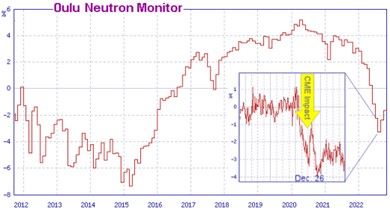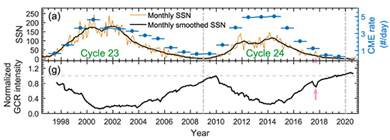Cosmic rays reaching Earth just hit a six-year low. Neutron counters in Oulu, Finland, registered the sudden decrease on 26 December 2022 when a coronal mass ejection (CME) hit Earth's magnetic field:

The CME swept aside galactic cosmic rays near our planet, abruptly reducing radiation levels. Researchers call this a "Forbush Decrease," after American physicist Scott Forbush, who studied cosmic rays in the early 20th century.
The 26 December event continues a trend that began in 2020. Since then, cosmic ray fluxes have been fitfully decreasing as one CME after another hit Earth. The reason is Solar Cycle 25, which began around that time and has been gaining strength. The Forbush Decreases are adding up.

Scott Forbush was the first to notice the yin-yang relationship between solar activity and cosmic rays. When one goes up, the other goes down. CMEs play a big role in this relationship. The solar storm clouds contain tangled magnetic fields that do a good job scattering cosmic rays away from our planet.
A recent paper in the Astrophysical Journal looked at the last two solar cycles and compared the daily rate of CMEs to the strength of cosmic rays near Earth. This plot shows the results:

At the peak of Solar Cycle 24, the sun was producing more than 5 CMEs per day. At the same time, galactic cosmic rays (GCRs) dropped more than 60%.
Neutron counts are now at their lowest level since 2016. If current trends continue, cosmic ray levels will plunge even further in the years ahead, perhaps even lower than Solar Cycle 24. This is good news for astronauts and polar air travellers who will benefit from less radiation.
Why neutrons?
When cosmic rays strike Earth’s atmosphere, they produce a spray of secondary particles that rain down on Earth. Among these particles are neutrons, which can make it all the way down to Earth's surface. Researchers at the Sodankyla Geophysical Observatory in Oulu, Finland, have been counting neutrons every day since 1964, providing an unparalleled record of cosmic rays for almost 60 years.














